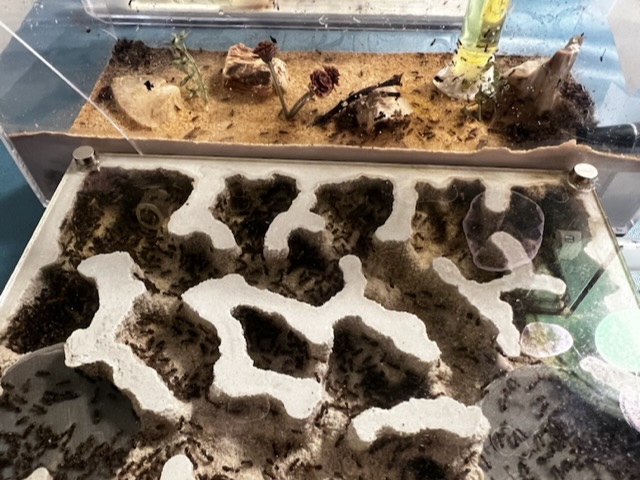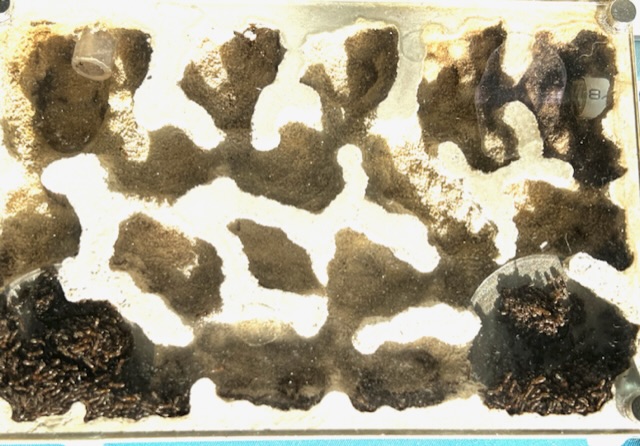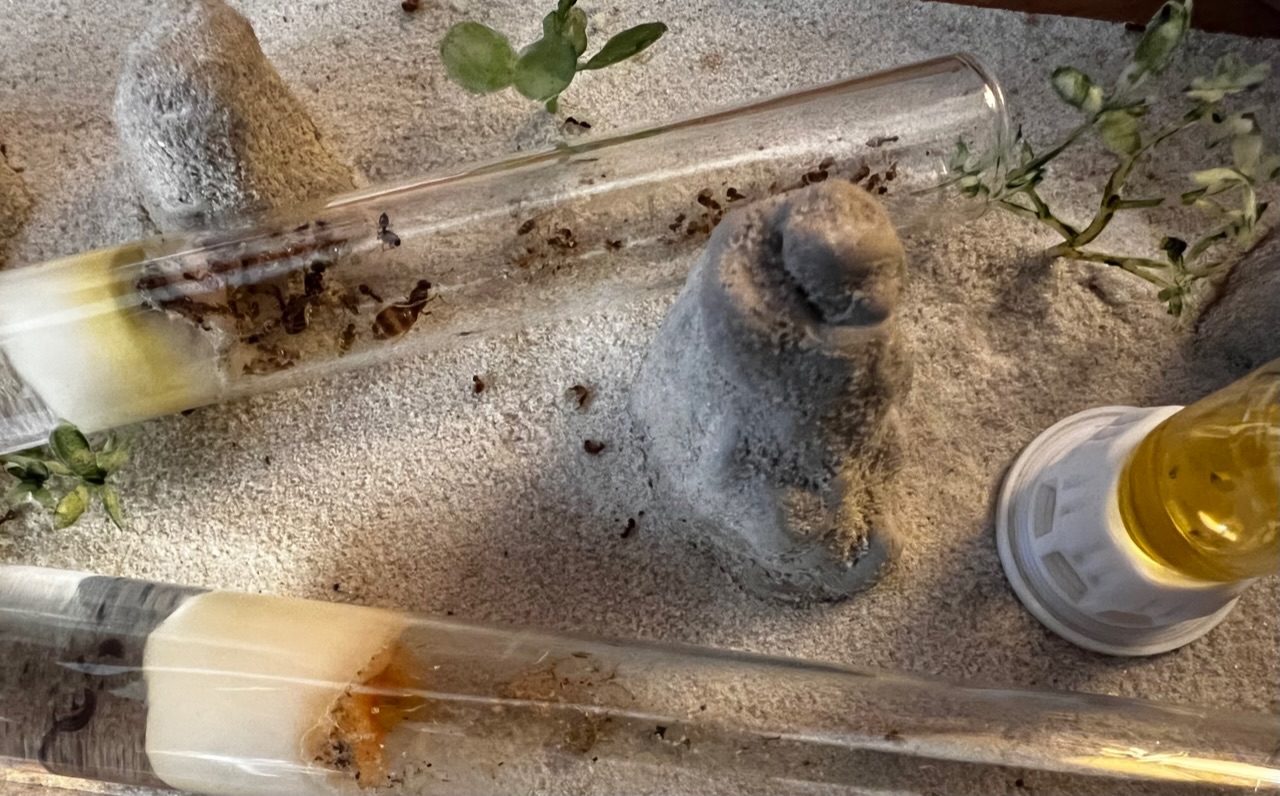oo, ahh
Edited by ArcaneAnt, July 11 2022 - 1:20 PM.

oo, ahh
Edited by ArcaneAnt, July 11 2022 - 1:20 PM.
Welllll lost my Myrmecocystus …. I will say the pots seemed EXTREMELY sensitive to what might be trace chemicals or something else in their environment.
Prenos - I still have a few from 2022. I was planning to do an experiment where I added new queens to existing colonies. However, this year (2023) they flew in March thanks to extreme California rainy weather, rather than the January or February of the last few years, and I pretty much missed the flights (though I knew they were happening because I saw a couple lost males). I caught one queen that sadly died within a couple days.
Lios are still okay so far (pic below).
Edited by OhNoNotAgain, March 22 2023 - 5:27 PM.
Formiculture Journals::
Veromessor pergandei, andrei; Novomessor cockerelli
Camponotus fragilis; also separate journal: Camponotus sansabeanus (inactive), vicinus, laevigatus/quercicola
Liometopum occidentale; Prenolepis imparis; Myrmecocystus mexicanus (inactive)
Pogonomyrmex subnitidus and californicus (inactive)
Tetramorium sp.
Termites: Zootermopsis angusticollis
Isopods: A. gestroi, granulatum, kluugi, maculatum, vulgare; C. murina; P. hoffmannseggi, P. haasi, P. ornatus; V. parvus
Spoods: Phidippus sp.
Lios were all bunched up in just 2-3 chambers most of the winter, but today I fed them (cooked bugs I froze months ago, plus a refill of their sugar water), put water into their water towers, refilled their water nestmate, and now they are very excited and have spread out to occupy all available space. Sort of like ant diffusion.

Edited by OhNoNotAgain, March 22 2023 - 5:30 PM.
Formiculture Journals::
Veromessor pergandei, andrei; Novomessor cockerelli
Camponotus fragilis; also separate journal: Camponotus sansabeanus (inactive), vicinus, laevigatus/quercicola
Liometopum occidentale; Prenolepis imparis; Myrmecocystus mexicanus (inactive)
Pogonomyrmex subnitidus and californicus (inactive)
Tetramorium sp.
Termites: Zootermopsis angusticollis
Isopods: A. gestroi, granulatum, kluugi, maculatum, vulgare; C. murina; P. hoffmannseggi, P. haasi, P. ornatus; V. parvus
Spoods: Phidippus sp.

Formiculture Journals::
Veromessor pergandei, andrei; Novomessor cockerelli
Camponotus fragilis; also separate journal: Camponotus sansabeanus (inactive), vicinus, laevigatus/quercicola
Liometopum occidentale; Prenolepis imparis; Myrmecocystus mexicanus (inactive)
Pogonomyrmex subnitidus and californicus (inactive)
Tetramorium sp.
Termites: Zootermopsis angusticollis
Isopods: A. gestroi, granulatum, kluugi, maculatum, vulgare; C. murina; P. hoffmannseggi, P. haasi, P. ornatus; V. parvus
Spoods: Phidippus sp.

Edited by OhNoNotAgain, April 3 2023 - 1:03 PM.
Formiculture Journals::
Veromessor pergandei, andrei; Novomessor cockerelli
Camponotus fragilis; also separate journal: Camponotus sansabeanus (inactive), vicinus, laevigatus/quercicola
Liometopum occidentale; Prenolepis imparis; Myrmecocystus mexicanus (inactive)
Pogonomyrmex subnitidus and californicus (inactive)
Tetramorium sp.
Termites: Zootermopsis angusticollis
Isopods: A. gestroi, granulatum, kluugi, maculatum, vulgare; C. murina; P. hoffmannseggi, P. haasi, P. ornatus; V. parvus
Spoods: Phidippus sp.
I have a whole bunch of Prenolepis videos at this point, on catching them, and now a check of my oldest Preno colony (entering its 3rd year).
Also, Liometopum made a quick cameo in my ant size video. I'll post a bunch of links to the Preno (and semi-Lio) videos:
Catching Prenolepis (2 years ago, 2022)
Catching Prenolepis (2024)
AFTER a Preno flight it's sad (2024)
Checking on Prenolepis after 2 years and after 2 months.
Includes some simple care instructions for Prenolepis.
Ant sizes matter, featuring Liometopum occidentale as well as Camponotus laevigatus
Edited by OhNoNotAgain, March 28 2024 - 7:20 PM.
Formiculture Journals::
Veromessor pergandei, andrei; Novomessor cockerelli
Camponotus fragilis; also separate journal: Camponotus sansabeanus (inactive), vicinus, laevigatus/quercicola
Liometopum occidentale; Prenolepis imparis; Myrmecocystus mexicanus (inactive)
Pogonomyrmex subnitidus and californicus (inactive)
Tetramorium sp.
Termites: Zootermopsis angusticollis
Isopods: A. gestroi, granulatum, kluugi, maculatum, vulgare; C. murina; P. hoffmannseggi, P. haasi, P. ornatus; V. parvus
Spoods: Phidippus sp.
So update:
Lio:
Still going. It's August and they are nursing a huge brood pile.
Preno:
I have grouped up the Prenolepis to save space, dividing the surviving starting queens as follows:
Bin 1: The 2 year old (3rd year?) colony is sharing its bin with a starter tube. (Said 3rd year colony also ran out of water in its tube, but refuses to move out....)
Bin 2: The other two starter tubes are sharing another bin, both open. The colonies are free to interact or merge.
As for the long-dead Myrmecocystus, I mayyyy try again this year.
Formiculture Journals::
Veromessor pergandei, andrei; Novomessor cockerelli
Camponotus fragilis; also separate journal: Camponotus sansabeanus (inactive), vicinus, laevigatus/quercicola
Liometopum occidentale; Prenolepis imparis; Myrmecocystus mexicanus (inactive)
Pogonomyrmex subnitidus and californicus (inactive)
Tetramorium sp.
Termites: Zootermopsis angusticollis
Isopods: A. gestroi, granulatum, kluugi, maculatum, vulgare; C. murina; P. hoffmannseggi, P. haasi, P. ornatus; V. parvus
Spoods: Phidippus sp.
I made a video about Liometopum occidentale as pets:
Formiculture Journals::
Veromessor pergandei, andrei; Novomessor cockerelli
Camponotus fragilis; also separate journal: Camponotus sansabeanus (inactive), vicinus, laevigatus/quercicola
Liometopum occidentale; Prenolepis imparis; Myrmecocystus mexicanus (inactive)
Pogonomyrmex subnitidus and californicus (inactive)
Tetramorium sp.
Termites: Zootermopsis angusticollis
Isopods: A. gestroi, granulatum, kluugi, maculatum, vulgare; C. murina; P. hoffmannseggi, P. haasi, P. ornatus; V. parvus
Spoods: Phidippus sp.
Just made an instructional video about combining Prenolepis imparis colonies (if in test tubes). Includes footage of a 3rd year Prenolepis colony that merged with a 1st year Prenolepis starter colony.
Edited by OhNoNotAgain, August 16 2024 - 10:24 PM.
Formiculture Journals::
Veromessor pergandei, andrei; Novomessor cockerelli
Camponotus fragilis; also separate journal: Camponotus sansabeanus (inactive), vicinus, laevigatus/quercicola
Liometopum occidentale; Prenolepis imparis; Myrmecocystus mexicanus (inactive)
Pogonomyrmex subnitidus and californicus (inactive)
Tetramorium sp.
Termites: Zootermopsis angusticollis
Isopods: A. gestroi, granulatum, kluugi, maculatum, vulgare; C. murina; P. hoffmannseggi, P. haasi, P. ornatus; V. parvus
Spoods: Phidippus sp.
0 members, 1 guests, 0 anonymous users